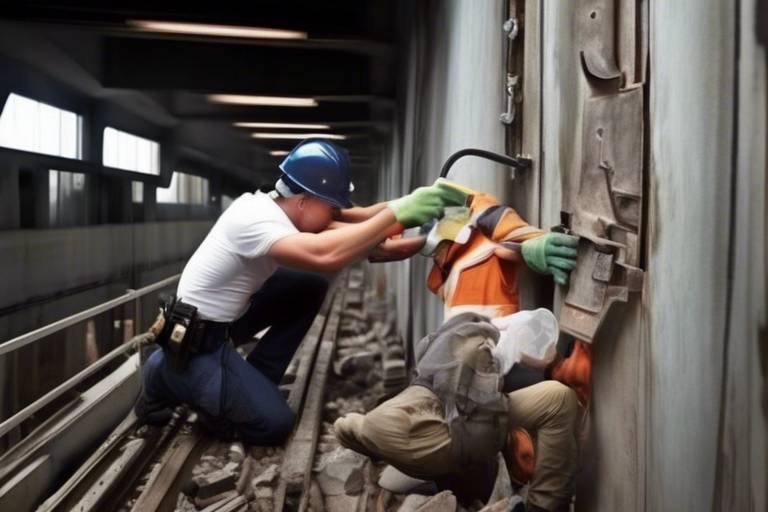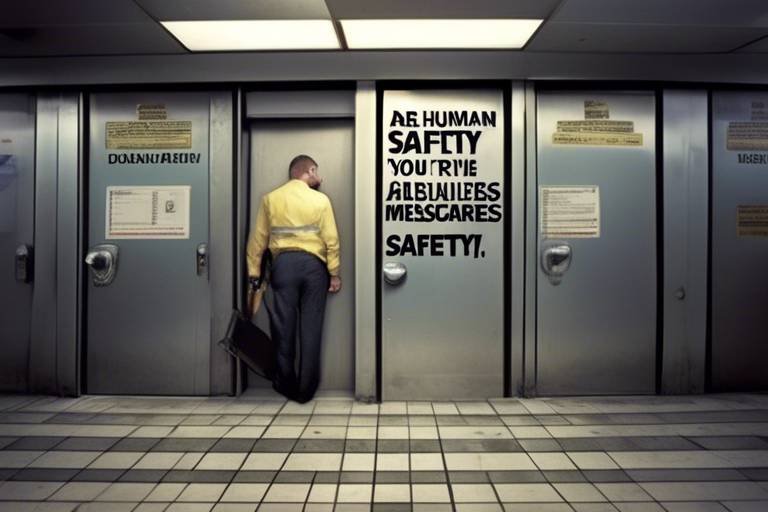Is Understanding Human Behavior Crucial for Designing Safety Plans?
When it comes to designing safety plans, one might think that the focus should solely be on procedures, regulations, and equipment. However, a major player often overlooked in this equation is human behavior. Understanding how people think, feel, and act in various situations is not just an added bonus; it’s a fundamental aspect that can make or break the effectiveness of safety protocols. Imagine a well-crafted safety plan that is ignored because it fails to resonate with the very individuals it aims to protect. This is where the intersection of psychology and safety comes into play.
Human behavior is influenced by a myriad of factors, from personal experiences to social dynamics. Recognizing these influences can lead to the development of safety strategies that not only comply with regulations but also engage individuals on a deeper level. For instance, if a safety plan is designed with an understanding of how fear can paralyze decision-making, it can incorporate elements that reduce anxiety and encourage proactive behaviors. This is crucial because when individuals feel confident and informed, they are more likely to follow safety guidelines.
Furthermore, the social context in which safety plans are implemented cannot be ignored. People are inherently social beings, and their behaviors are often shaped by the actions and attitudes of those around them. For example, if a workplace culture promotes safety as a collective responsibility, individuals are more likely to engage in safe practices. On the flip side, if peers disregard safety measures, others may feel compelled to follow suit, undermining the entire safety initiative.
In summary, understanding human behavior is not just an academic exercise; it is a critical component of effective safety plan design. By delving into the psychological and social factors that influence behavior, organizations can create safety plans that are not only compliant but also compelling. This approach ensures that safety measures are not only understood but embraced, leading to a safer environment for everyone involved.

The Importance of Human Behavior in Safety
Understanding human behavior is essential for creating effective safety plans, as it helps to identify potential risks and develop strategies that resonate with individuals' motivations and responses in crisis situations. Imagine walking into a workplace where safety protocols are in place, yet employees seem oblivious to them. Why does this happen? Often, it’s because the plans were designed without a true understanding of how people think and act. By delving into the psychology behind human behavior, we can craft safety measures that are not only more effective but also more likely to be followed.
When we consider safety, we often think of physical measures—like fire alarms or safety gear. However, the human element is just as crucial. For example, if employees do not see the value in wearing protective equipment, they are less likely to comply. This brings us to the idea of motivation. What drives individuals to adhere to safety guidelines? Is it fear of consequences, a desire to protect themselves and others, or perhaps a sense of duty? By tapping into these motivations, we can create a culture of safety that feels personal and relevant.
Moreover, the social context in which individuals operate can significantly influence their behavior. Peer pressure can either encourage compliance or lead to negligence. For instance, if a group of employees consistently disregards safety protocols, others may feel compelled to follow suit, thinking, “If they’re not worried, why should I be?” Thus, incorporating an understanding of social dynamics into safety plan design is not just beneficial; it’s essential.
To illustrate this point, let’s consider a table that outlines various human behaviors and their potential impact on safety compliance:
| Behavior | Impact on Safety Compliance |
|---|---|
| Risk Perception | High risk perception can lead to increased adherence to safety protocols. |
| Peer Influence | Positive peer pressure can enhance compliance, while negative peer influence can diminish it. |
| Motivation | Intrinsic motivation (personal safety) often results in better compliance than extrinsic motivation (fear of punishment). |
In conclusion, the importance of understanding human behavior in safety cannot be overstated. It’s not just about creating rules and regulations; it’s about fostering an environment where individuals feel empowered and motivated to follow those rules. By considering psychological and social factors, we can design safety plans that resonate with people on a deeper level, ultimately enhancing compliance and improving safety outcomes across various environments.

Psychological Factors Influencing Safety Compliance
When it comes to safety compliance, psychological factors play a pivotal role in shaping how individuals react to safety protocols. Understanding these factors is akin to peeling back the layers of an onion; each layer reveals a deeper insight into why people behave the way they do in potentially hazardous situations. For instance, an individual's perception of risk can significantly dictate their adherence to safety measures. If someone perceives a situation as low-risk, they may be less likely to follow safety protocols, thinking, "Oh, it won't happen to me!" This mindset can lead to dangerous oversights.
Furthermore, motivation is another critical psychological element. People are often motivated by a range of factors—personal safety, financial incentives, or even social approval. For example, if employees believe that following safety guidelines will not only protect them but also earn them recognition from their peers or supervisors, they are more likely to comply. This is where the concept of behavioral economics comes into play, as it helps us understand how to nudge individuals toward safer behaviors by aligning incentives with their motivations.
Another psychological factor that cannot be overlooked is fear. While fear can sometimes be a powerful motivator for compliance, it can also lead to avoidance behaviors. If individuals are overwhelmed by fear, they may shut down or refuse to engage with safety protocols altogether. For instance, during an emergency drill, if the scenario is presented in an overly dramatic way, it might incite panic rather than preparedness. Thus, striking the right balance in how we communicate risks and safety measures is crucial.
The perception of risk is a fascinating psychological phenomenon that varies from person to person. Some individuals might see a particular hazard as a significant threat, while others might dismiss it entirely. This discrepancy can lead to a lack of uniformity in safety compliance across a group. For example, consider a workplace where some employees believe that wearing personal protective equipment (PPE) is unnecessary because they have never experienced an accident. This mindset can be detrimental, as it creates a culture where safety is not prioritized.
To effectively address these perceptions, organizations must implement risk communication strategies that resonate with their audience. Clear, concise, and relatable messaging can help individuals better understand the threats they face. For example, using real-life scenarios and statistics can make the risks more tangible. A well-crafted message might include:
| Communication Strategy | Purpose |
|---|---|
| Use of Visual Aids | To illustrate risks and safety measures clearly. |
| Storytelling | To create emotional connections and enhance understanding. |
| Regular Training Sessions | To reinforce the importance of safety protocols and keep them top of mind. |
By employing these strategies, organizations can foster a culture of safety that encourages compliance and promotes overall well-being. However, it is essential to remember that communication should be a two-way street; feedback from individuals can provide valuable insights into how messages are received and understood.
Applying principles of behavioral economics can help design safety plans that encourage compliance by leveraging incentives and nudges that align with human decision-making processes. For instance, introducing a reward system for teams that consistently follow safety protocols can create a healthy competition that motivates individuals to adhere to guidelines. This approach not only enhances safety compliance but also fosters a sense of camaraderie among team members, as they work together to achieve a common goal.
In conclusion, understanding the psychological factors influencing safety compliance is crucial for developing effective safety plans. By addressing perceptions of risk, motivations, and fears, organizations can create an environment where safety is prioritized, leading to improved outcomes for everyone involved.

Perception of Risk
The plays a pivotal role in shaping how individuals respond to safety protocols and emergency situations. It's fascinating to think about how our brains process information about potential dangers. For instance, when faced with a crisis, some people might react with caution, while others may underestimate the threat entirely. This discrepancy often stems from personal experiences, cultural background, and even media influence. Understanding this variability is crucial for developing effective safety measures that resonate with everyone.
One key aspect of risk perception is that it is not always based on statistical probabilities. Instead, it often hinges on emotional responses. For example, if someone has had a negative experience related to a specific hazard—like a car accident—they may perceive that risk as much higher than someone who has never encountered such an event. This emotional lens can distort reality, leading to either an exaggerated sense of danger or a dangerous underestimation of risk.
To illustrate this point further, let’s consider a few factors that influence risk perception:
- Familiarity: The more familiar people are with a risk, the less threatening it may seem. For instance, someone who regularly drives may perceive the risk of car accidents as lower compared to someone who rarely drives.
- Media Coverage: Events that receive extensive media attention, like natural disasters or pandemics, can skew public perception, making them seem more common than they actually are.
- Social Influence: Peer opinions can significantly shape how individuals assess risk. If a person's friends downplay a potential danger, they might adopt a similar mindset.
By understanding these factors, organizations can tailor their safety communications to address common misconceptions and enhance compliance. For instance, clear and relatable messaging can help demystify risks and promote a more accurate understanding of safety protocols. This is where risk communication strategies come into play, aiming to bridge the gap between perception and reality.
Furthermore, behavioral economics provides valuable insights into how people make decisions regarding risk. By leveraging these insights, safety plans can be designed to encourage better decision-making and compliance. For example, using simple language and relatable examples can help individuals grasp the seriousness of a risk, prompting them to take necessary precautions.
Ultimately, recognizing that perception of risk varies widely among individuals is essential for creating effective safety strategies. Tailoring communications to address these perceptions not only enhances understanding but also fosters a culture of safety where individuals feel empowered to act responsibly during emergencies.

Risk Communication Strategies
Effective risk communication strategies are pivotal in enhancing safety compliance and ensuring that individuals understand the potential dangers they face. It’s not just about relaying information; it’s about crafting messages that resonate with people's emotions and perceptions. Imagine trying to convince someone to wear a seatbelt. Simply stating, “It’s the law” may not be enough. Instead, you could say, “Wearing a seatbelt can save your life and the lives of your loved ones.” This approach taps into their emotional instincts and highlights the personal stakes involved.
One of the critical aspects of risk communication is clarity. People often feel overwhelmed by technical jargon and complex information. Therefore, using simple, straightforward language can significantly enhance understanding. For instance, instead of saying “There is a high probability of adverse events,” you might say, “There’s a good chance you could get hurt if you don’t follow these safety rules.” This directness can make a world of difference in how the message is received.
Another effective strategy is to utilize visual aids. Humans are visual creatures, and incorporating graphics, charts, or even videos can help convey the message more effectively. For instance, a video demonstrating the proper use of safety equipment can be much more impactful than a written manual. Visuals can simplify complex information and make it more relatable, which is crucial in high-stress situations.
Moreover, engaging individuals through interactive communication can foster a deeper understanding of risks. This could involve workshops, role-playing scenarios, or even online simulations that allow individuals to experience potential risks in a controlled environment. By actively participating, people are more likely to remember the information and apply it when needed.
Finally, it’s essential to create a feedback loop in your risk communication strategy. Encouraging individuals to ask questions and express their concerns can provide valuable insights into their perceptions of risk. This two-way communication not only enhances understanding but also builds trust. When people feel heard, they are more likely to comply with safety measures. Regularly updating your communication strategies based on this feedback ensures that your messages remain relevant and effective.
In summary, effective risk communication strategies should include:
- Clear and straightforward language
- Use of visual aids to simplify information
- Interactive methods to engage individuals
- Creating a feedback loop for continuous improvement
By implementing these strategies, organizations can significantly improve safety compliance and foster a culture of awareness and preparedness.
Q: Why is risk communication important in safety plans?
A: Risk communication is crucial because it helps individuals understand potential dangers, leading to better compliance with safety measures and improved overall safety outcomes.
Q: How can visuals enhance risk communication?
A: Visual aids can simplify complex information, making it easier for individuals to grasp critical safety concepts and remember them during emergencies.
Q: What role does feedback play in risk communication?
A: Feedback allows organizations to adjust their communication strategies based on individuals' perceptions and concerns, ensuring that messages remain effective and relevant.

Behavioral Economics in Safety
Behavioral economics is a fascinating field that merges psychology and economics to understand how people make decisions. In the context of safety, applying principles of behavioral economics can lead to innovative strategies that enhance compliance with safety protocols. Imagine a workplace where employees are not just following rules because they have to, but because they genuinely want to. This shift in mindset can be achieved by leveraging insights from behavioral economics, which focuses on how various factors influence decision-making.
One of the core concepts in behavioral economics is the idea of nudges. A nudge is a subtle change in the environment that can significantly influence people's behavior without restricting their freedom of choice. For instance, if a company places hand sanitizers in visible and accessible locations, employees are more likely to use them. This simple adjustment is a nudge that aligns with human tendencies, promoting healthier habits without mandating them. By understanding these psychological triggers, safety plans can be designed to encourage positive behaviors naturally.
Another important aspect is the use of incentives. People are often motivated by rewards, whether they are tangible or intangible. For example, a safety program that offers recognition or small rewards for compliant behavior can foster a culture of safety. When individuals feel appreciated for adhering to safety protocols, they are more likely to continue those behaviors. This concept ties back to the psychological principle of positive reinforcement, where behaviors are encouraged through rewards, leading to a more engaged workforce.
Moreover, behavioral economics emphasizes the significance of framing. How information is presented can drastically alter perceptions and decisions. For instance, instead of stating, “Only 10% of people get injured when following safety protocols,” a more effective approach might be, “90% of people stay safe when they follow these protocols.” This positive framing can encourage individuals to view safety measures in a more favorable light, thus increasing compliance rates. Understanding the nuances of how information is framed allows organizations to craft messages that resonate better with their audience.
To illustrate these concepts further, consider the following table that highlights different behavioral economics strategies and their applications in safety:
| Strategy | Description | Application in Safety |
|---|---|---|
| Nudges | Subtle changes in the environment to influence behavior | Positioning safety equipment in high-traffic areas |
| Incentives | Rewards or recognition to encourage compliance | Monthly safety awards for teams with zero incidents |
| Framing | Presenting information in a way that influences perception | Highlighting positive outcomes of following safety protocols |
In summary, integrating behavioral economics into safety plan design is not just about creating rules; it’s about understanding the human psyche and using that knowledge to foster a culture of safety. By applying nudges, incentives, and effective framing, organizations can significantly enhance compliance and ensure that safety becomes a shared value among employees. As we continue to explore the intersection of human behavior and safety, the potential for creating safer environments becomes not only a possibility but a reality.
- What is behavioral economics? Behavioral economics is a field that studies how psychological factors influence economic decision-making.
- How can nudges improve safety compliance? Nudges can subtly encourage individuals to follow safety protocols without restricting their choices.
- What role do incentives play in safety? Incentives can motivate individuals to adhere to safety measures by rewarding compliant behavior.
- Why is framing important in safety communication? Framing affects how information is perceived, which can influence individuals' willingness to comply with safety protocols.

Social Influences on Safety Behavior
When we think about safety, we often focus on protocols, equipment, and regulations, but what about the social influences that shape our behavior in these contexts? Believe it or not, our interactions with others can significantly impact how we respond to safety measures. Just like the ripples in a pond, the actions and attitudes of those around us can either enhance or undermine our commitment to safety protocols. For instance, if a group of coworkers is lax about wearing safety gear, an individual may feel less inclined to adhere to guidelines, thinking, "If they aren't worried, why should I be?"
Social dynamics play a crucial role in shaping our perceptions and behaviors. We are inherently social beings, and the desire to fit in or gain approval from our peers can lead us to conform to group norms, even when those norms may not prioritize safety. This phenomenon is often referred to as peer influence, and it can be a double-edged sword. On one hand, positive peer pressure can encourage individuals to adopt safer behaviors; on the other hand, negative peer pressure can lead to risky behaviors that compromise safety.
To illustrate this concept, consider the following scenarios:
- Positive Peer Influence: In a workplace where safety is prioritized, team members encourage each other to follow safety protocols, leading to a culture of safety.
- Negative Peer Influence: In contrast, if a group of friends decides to skip safety equipment while engaging in a hazardous activity, an individual may feel compelled to join in, disregarding their own safety.
Moreover, the role of social norms cannot be underestimated. Norms are the unwritten rules that govern behavior within a group. If safety is seen as a collective responsibility, individuals are more likely to engage in safe practices. Conversely, if safety is viewed as a personal choice, compliance may wane. This is why it's essential for organizations to cultivate a strong safety culture where everyone feels accountable for each other's well-being.
Another aspect to consider is the influence of leadership on safety behavior. Leaders who actively promote safety and model safe behaviors can inspire their teams to follow suit. When leaders prioritize safety, it sends a clear message that safety is not just a checklist item but a core value. This alignment can foster an environment where employees feel empowered to speak up about unsafe practices, ultimately leading to better safety outcomes.
In summary, understanding the social influences on safety behavior is vital for designing effective safety plans. By recognizing the impact of peer pressure, social norms, and leadership, organizations can create strategies that not only address individual behaviors but also harness the power of social dynamics to promote a culture of safety. After all, safety isn't just about rules and regulations; it's about people working together to create a safer environment for everyone.
- What are social influences in safety behavior?
Social influences refer to the effects that the attitudes and behaviors of others have on an individual's decisions regarding safety practices. - How can organizations improve safety compliance through social dynamics?
By fostering a positive safety culture and encouraging peer support, organizations can enhance compliance and promote safe behaviors among employees. - What role does leadership play in safety behavior?
Leaders set the tone for safety within an organization. Their commitment to safety can inspire employees to prioritize safety in their own actions.

Creating Safety Plans Based on Behavioral Insights
When it comes to designing safety plans, simply following regulations and guidelines is not enough. It's crucial to delve into the behavioral insights that can shape the effectiveness of these plans. By understanding how individuals think and react in various situations, organizations can create safety strategies that not only comply with standards but also resonate on a personal level. Imagine trying to teach someone to swim by just throwing them into the deep end without any guidance—similarly, safety plans need to be tailored to ensure individuals feel equipped and motivated to respond appropriately in emergencies.
One of the most effective ways to incorporate behavioral insights is by customizing safety training programs. Rather than adopting a one-size-fits-all approach, organizations should assess the specific behavioral tendencies of their workforce. For instance, if employees are known to be risk-averse, training can emphasize the importance of proactive measures and how these can mitigate perceived threats. Additionally, using real-life scenarios in training can help individuals relate better and understand the relevance of the protocols being taught. This method not only enhances engagement but also ensures that the information sticks, making it more likely that individuals will remember and apply what they've learned when it matters most.
Moreover, evaluating safety plan effectiveness is an ongoing process that requires regular feedback and adjustments based on behavioral responses. Organizations can implement surveys or focus groups to gather insights on how employees feel about the safety measures in place. This feedback loop is invaluable; it allows for the identification of areas where individuals may feel confused or resistant, enabling organizations to adapt their strategies accordingly. For example, if employees express uncertainty about evacuation routes, safety plans can be revised to include clearer signage or more frequent drills, thus addressing the issue head-on.
Another key component is understanding the social influences that affect behavior. Humans are inherently social beings, and the actions of peers can greatly impact individual compliance with safety protocols. By fostering a culture of safety where employees feel responsible not just for their own safety but also for that of their colleagues, organizations can enhance overall adherence to safety plans. This can be achieved through team-building exercises that emphasize collective responsibility and by recognizing and rewarding safe behaviors within teams.
In conclusion, creating safety plans based on behavioral insights is not just about compliance; it's about fostering an environment where safety is a shared value. By customizing training, regularly evaluating effectiveness, and leveraging social dynamics, organizations can design safety plans that truly resonate with individuals. This approach not only enhances compliance but also cultivates a proactive safety culture that can significantly reduce risks and improve outcomes.
- Why is understanding human behavior important in safety plan design?
Understanding human behavior helps identify potential risks and develop strategies that resonate with individuals' motivations and responses, ultimately enhancing safety outcomes. - How can organizations customize safety training programs?
Organizations can customize training by assessing specific behavioral tendencies and incorporating real-life scenarios to make the training more relatable and engaging. - What role does social influence play in safety compliance?
Social dynamics, such as peer influence and group behavior, significantly impact individual adherence to safety protocols, making it essential to consider these factors in safety plan design. - How can organizations evaluate the effectiveness of their safety plans?
Regular evaluation through feedback mechanisms like surveys and focus groups allows organizations to adapt and improve safety strategies based on behavioral responses.

Tailoring Safety Training Programs
When it comes to safety training programs, one size definitely does not fit all. Just like a tailor adjusts a suit to fit perfectly, safety training needs to be customized to align with the unique behaviors and tendencies of the individuals involved. Imagine trying to teach a group of diverse employees using the same method; it’s like trying to fit a square peg into a round hole. By understanding the specific needs and characteristics of your audience, you can create a training program that resonates with them, making it more engaging and effective.
To start, consider the various learning styles of your audience. Some individuals may prefer hands-on activities, while others might benefit more from visual aids or interactive discussions. By incorporating a mix of training methods, you can cater to different preferences, ensuring that everyone has the opportunity to absorb the material effectively. For instance, utilizing simulations or role-playing scenarios can help individuals practice their responses to emergency situations in a controlled environment, boosting their confidence and readiness.
Moreover, it’s crucial to incorporate real-life examples that are relevant to the participants’ daily activities. When individuals can see how safety protocols apply to their specific roles, they are more likely to understand the importance of compliance. You might even consider involving employees in the creation of training content. This not only fosters a sense of ownership but also ensures that the training reflects the realities of their work environment.
Another key aspect of tailoring safety training is to continuously gather feedback. After each training session, encourage participants to share their thoughts on what worked well and what could be improved. This feedback loop allows you to refine the program over time, making it more effective and relevant. Additionally, consider using behavioral assessments before and after training to measure improvements in safety compliance. This data can be invaluable in demonstrating the effectiveness of your tailored approach.
Ultimately, the goal of tailoring safety training programs is to create a culture of safety that permeates throughout the organization. When individuals feel that the training speaks directly to their experiences and needs, they are more likely to embrace safety protocols and act responsibly in emergency situations. Remember, a well-trained employee is not just a compliant one; they are a confident one, ready to respond effectively when it matters most.
- Why is it important to tailor safety training programs?
Tailoring safety training ensures that the content is relevant and engaging for participants, leading to better understanding and compliance. - What are some effective methods for customizing safety training?
Using a mix of hands-on activities, real-life examples, and participant feedback can enhance the effectiveness of safety training. - How can I measure the effectiveness of a tailored safety training program?
Regular feedback from participants and behavioral assessments before and after training can help gauge improvements in safety compliance.

Evaluating Safety Plan Effectiveness
Evaluating the effectiveness of safety plans is not just a checkbox exercise; it’s a vital process that can mean the difference between life and death in critical situations. Think of it as a health check for your safety protocols. Just like you wouldn’t ignore symptoms when your body is unwell, organizations must regularly assess their safety plans to ensure they are functioning optimally. This involves a systematic approach that includes collecting data, analyzing feedback, and making necessary adjustments to strategies.
One of the first steps in this evaluation process is collecting feedback from those who are directly involved with the safety protocols. Employees on the ground often have the best insights into what works and what doesn’t. Surveys, interviews, and focus groups can be effective tools for gathering this information. It’s essential to create an environment where individuals feel comfortable sharing their honest opinions. After all, if people fear repercussions for speaking up, you may not get the full picture.
Once feedback is collected, the next step is to analyze the data. This is where the magic happens! By looking at patterns and trends, organizations can identify areas that need improvement. For example, if a significant number of employees report confusion about emergency procedures, it might indicate a need for clearer communication or additional training sessions. Furthermore, using metrics such as compliance rates and incident reports can provide quantitative data that complements qualitative feedback.
After analyzing the feedback, it’s time to implement changes. This is where organizations can truly shine by showing their commitment to safety. Whether it’s revising training programs, updating communication methods, or even redesigning safety protocols, being proactive about these changes can greatly enhance overall safety outcomes. It’s like tuning a musical instrument; a little adjustment can lead to a much more harmonious performance.
Finally, it’s crucial to establish a cycle of continuous improvement. Evaluating safety plans shouldn’t be a one-time event but rather an ongoing process. By regularly revisiting and reassessing safety protocols, organizations can adapt to new challenges and ensure that their strategies remain relevant. This could involve setting up a schedule for periodic reviews or integrating evaluation into regular team meetings. The goal is to foster a culture of safety where everyone feels responsible for contributing to a secure environment.
In summary, evaluating safety plan effectiveness is an essential practice that encompasses feedback collection, data analysis, implementation of changes, and continuous improvement. By actively engaging with employees and making informed adjustments, organizations can create a safer workplace for everyone. Remember, safety isn’t just a policy; it’s a culture that grows stronger with each evaluation and adaptation.
- Why is it important to evaluate safety plans? Regular evaluations help identify weaknesses in safety protocols and ensure that they are effective in real-life scenarios.
- What methods can be used to collect feedback? Surveys, interviews, and focus groups are effective methods to gather insights from employees about safety protocols.
- How often should safety plans be evaluated? Safety plans should be evaluated regularly, ideally on a quarterly or bi-annual basis, to ensure they remain effective and relevant.
- What should be done with the feedback received? Feedback should be analyzed to identify trends and areas for improvement, and then used to make necessary adjustments to safety protocols.
Frequently Asked Questions
- Why is understanding human behavior important for safety plans?
Understanding human behavior is crucial for safety plans because it helps identify potential risks and develop strategies that align with individuals' motivations and reactions during crises. This insight allows for the creation of more effective and compliant safety measures.
- What psychological factors influence safety compliance?
Psychological factors such as perception of risk, motivation, and fear significantly affect how individuals respond to safety protocols. These elements can dictate whether people adhere to guidelines and procedures, making it essential to consider them when designing safety plans.
- How does perception of risk affect safety behavior?
Individuals' perceptions of risk play a vital role in their behavior during safety situations. If people perceive a threat as significant, they are more likely to follow safety measures. Understanding these perceptions can lead to better communication strategies and more effective safety practices.
- What are effective risk communication strategies?
Effective risk communication strategies involve clear messaging that enhances understanding of potential dangers. This clarity can lead to improved compliance with safety measures, ultimately resulting in better safety outcomes for everyone involved.
- How can behavioral economics be applied to safety plans?
Behavioral economics can be utilized in safety plans by incorporating incentives and nudges that align with how people make decisions. By understanding human decision-making processes, safety plans can be designed to encourage compliance more effectively.
- What role do social influences play in safety behavior?
Social dynamics, such as peer influence and group behavior, significantly impact individual adherence to safety protocols. Recognizing these social factors is essential for designing safety plans that promote collective compliance and enhance overall safety.
- How can safety training programs be tailored to behavioral insights?
Tailoring safety training programs to address specific behavioral tendencies can boost engagement and retention. Customized training ensures that individuals are better prepared for emergencies, making them more likely to follow safety protocols effectively.
- Why is it important to evaluate safety plan effectiveness regularly?
Regular evaluation of safety plans based on behavioral feedback allows organizations to adapt and improve their strategies continuously. This ongoing assessment ensures that safety measures remain effective and compliant, catering to diverse situations and changing behaviors.



















